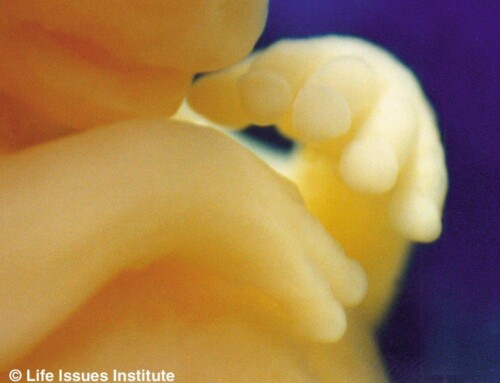
The evidence of fetal pain
With the advent of sonograms and live-action ultrasound images, neonatologists and nurses are able to see unborn babies at 20 weeks gestation react physically to outside stimuli such as sound, light and touch. The sense of touch is so acute that even a single human hair drawn across an unborn child’s palm causes the baby to make a fist.
- Surgeons entering the womb to perform corrective procedures on tiny unborn children have seen those babies flinch, jerk and recoil from sharp objects and incisions.
- “The neural pathways are present for pain to be experienced quite early by unborn babies.”
– Steven Calvin, M.D., perinatologist, chair of the Program in Human Rights Medicine, University of Minnesota, where he teaches obstetrics
The evidence of fetal pain
With the advent of sonograms and live-action ultrasound images, neonatologists and nurses are able to see unborn babies at 20 weeks gestation react physically to outside stimuli such as sound, light and touch. The sense of touch is so acute that even a single human hair drawn across an unborn child’s palm causes the baby to make a fist.
- Surgeons entering the womb to perform corrective procedures on tiny unborn children have seen those babies flinch, jerk and recoil from sharp objects and incisions.
- “The neural pathways are present for pain to be experienced quite early by unborn babies.”
– Steven Calvin, M.D., perinatologist, chair of the Program in Human Rights Medicine, University of Minnesota, where he teaches obstetrics
Medical facts of fetal pain
Anatomical studies have documented that the body’s pain network – the spino-thalamic pathway – is established by 20 weeks gestation.
- “At 20 weeks, the fetal brain has the full complement of brain cells present in adulthood, ready and waiting to receive pain signals from the body, and their electrical activity can be recorded by standard electroencephalography (EEG).”
– Dr. Paul Ranalli, neurologist, University of Toronto
- An unborn child at 20 weeks gestation “is fully capable of experiencing pain. … Without question, [abortion] is a dreadfully painful experience for any infant subjected to such a surgical procedure.”
– Robert J. White, M.D., PhD., professor of neurosurgery, Case Western University
Unborn babies have heightened sensitivities
Unborn children at 20 weeks development actually feel pain more intensely than adults. This is a “uniquely vulnerable time, since the pain system is fully established, yet the higher level pain-modifying system has barely begun to develop.”
– Dr. Paul Ranalli, neurologist, University of Toronto
- “Having administered anesthesia for fetal surgery, I know that on occasion we need to administer anesthesia directly to the fetus, because even at these early gestational ages the fetus moves away from the pain of the stimulation.”
– David Birnbach, M.D., president of the Society for Obstetric Anesthesia and Perinatology and self-described as “pro-choice,” in testimony before the U.S. Congress
The unborn child at 20 weeks
Fetal development is already quite advanced at 20 weeks gestation:
- The skeleton is complete and reflexes are present at 42 days.
- Electrical brain wave patterns can be recorded at 43 days. This is usually ample evidence that “thinking” is taking place in the brain.
- The fetus has the appearance of a miniature baby, with complete fingers, toes and ears at 49 days.
- All organs are functioning – stomach, liver, kidney, brain – and all systems are intact at 56 days.
- By 20 weeks, the unborn child has hair and working vocal cords, sucks her thumb, grasps with her hands and kicks. She measures 12 inches.
Abortion at 20 weeks
Despite the unborn child’s advanced development at 20 weeks, the following painful abortion procedures are used:
- Partial-birth abortion (D&X): The unborn baby is delivered feet first, except for the head, which is punctured at the base of the skull with a sharp object. The brain is then suctioned out, killing the child.
- Dilation and Evacuation (D&E): Sharp-edged instruments are used to grasp, twist and tear the baby’s body into pieces, which are removed from the womb.
- Saline instillation: Salt water is injected into the womb through the mother’s abdomen. The unborn baby swallows this fluid, is poisoned and dies in a process that sometimes takes 24 hours. The toxic saline solution causes severe burns over the unborn child’s entire body.
Reprinted with permission from Minnesota Citizens Concerned for Life, 2006.


